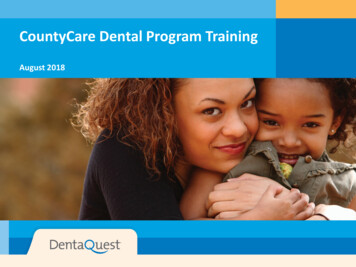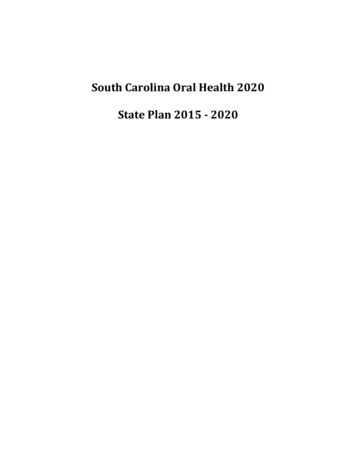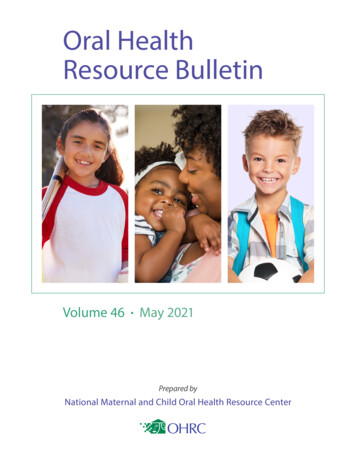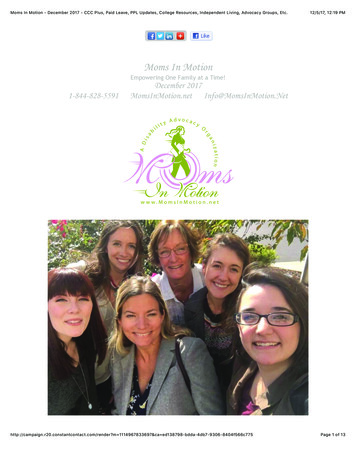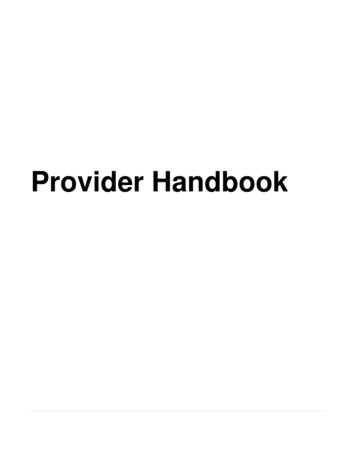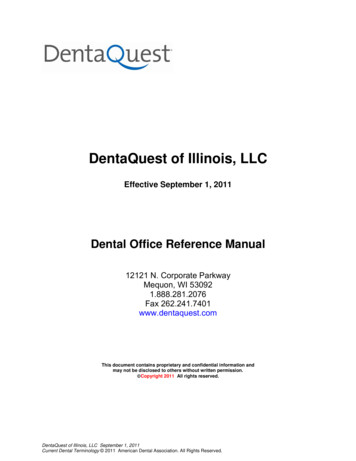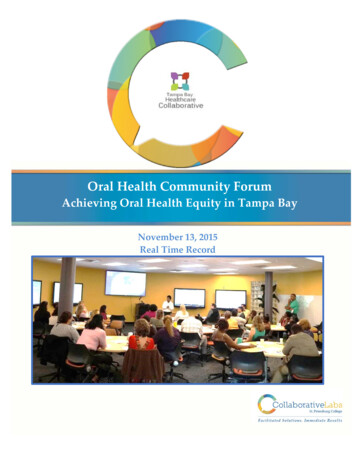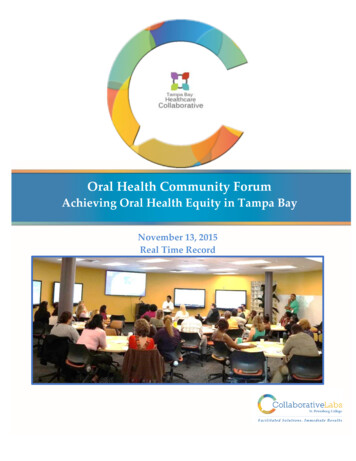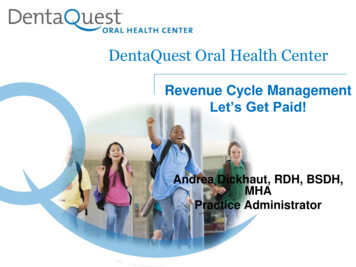
Transcription
DentaQuest Oral Health CenterRevenue Cycle ManagementLet’s Get Paid!Andrea Dickhaut, RDH, BSDH,MHAPractice Administrator
Our office Multi-specialty group practiceWestborough, MA13 Operatories14,500 patients of recordAccept all insurancesPrevention orientedEvidence-based protocols of careMinimally invasive dentistry– Emphasis on remineralization of caries– Non surgical management of periodontal disease
What is RCMWhy do we care?What can go wrong?Let’s take a tour!How to streamline and improve theprocess Recommendations Discussion
RCM is the time between when anappointment is scheduled and when youreceive final payment for the work you’vedone (or the claim is written off)
If the cycle is longthere’s a potential for more write-offsIf the cycle is shortit will speed up your payment and increaseyour cash flow
Financial sustainability for your dental programIncrease cash flowImprove net collectionsDecrease denied claimsDecrease frustrationIdentify factors that impact your bottom line
With so much money on at stake, why do somany of us struggle with Revenue CycleManagement?Well .let’s see
A/R Over 90 Days—Actual SNS Client! 886,229 Self Pay 654,633 Medicaid 102,461 Medicaid/Managed Care 48,564 CommercialTotal money left on the table: 1.7 million!
How many steps are there and how many people does ittake to get from start to finish? Steep learning curve Each step comes with a potential point of failure Every patient represents a new cycle, so these steps orcombination of steps could possibly occur hundreds oftimes each week. Staffing for a successful team can be difficult
Typical reasons why dental programs leave money on thetable: Provide services that are not covered Provide services to patients who say they haveinsurance (but don’t) The revenue cycle process is flawed at some point ofcontact Failure to hold patients accountable for paying theirshare of charges at the time of the visit
Not having a dedicated dental biller Not having an interface between EDR and EMRto send charges over Manual charge entry vastly increases likelihoodof human error resulting in lost revenue Should we bill out of EMR or EDR?
Using obsolete codes (eg, D1203 instead ofD1206 or D1208) Using the wrong code Codes charged out but procedures notreferenced in clinical notes Procedures referenced in clinical notes butnot charged out Referencing one procedure in the clinicalnotes but charging out a different code
Set up a Revenue Cycle ManagementProtocol
The Goal of this process is to create a cleanclaim for submittal and paymentLet’s shrink the Revenue Cycle Process!
Prior to Appointment Collects Patient demographics Verifies insurance for eligibility Breakdown of Benefits Obtains a History of services provided Makes sure Correct Fee schedule is attached
Verifies Eligibility again Makes copy of insurance card Verifies insurance and demographics
Patient is seen and all procedures areentered into the EDR and completed A treatment plan is developed andsequenced Patient is escorted to front desk for checkout process
Coding Critical for making sure we get paid for the work we do Critical for making sure we avoid coding errors thatcould result in fines or worse The responsibility for coding correctly ultimatelyrests with the provider Complete and accurate documentation of the patientencounter is crucial ALWAYS use the proper codes for the actual dentalservices provided Just because it’s a dental code, doesn’t mean it’s a“covered” code
Review treatment plan in presenterReview financial obligations with patientPatient signs treatment planCollection of co-payment if necessarySchedule next appointment
Step 5Creation of a Dental Claim Front desk will review and create the claimfor submittal Send a prior authorization if necessary Attach any necessary documentation
Review encounter forms or charges to ensureaccuracy and completeness Submit claims electronically in a timely manner Reconcile payments and post to patient accounts Investigate, correct and resubmit denied claims in atimely manner Identify trends (ie, reasons for denials) Send out monthly statements to patients withoutstanding balances Stay up-to-date with changes in insurance rules andregulations and communicate changes to dental staffand/or leadership
Successful TeamsThe most successful teams usecontinuous improvement approaches to“shrink” the revenue cycle.So who else can help?
Front DeskClinical StaffBilling StaffDental Practice LeadershipAdministrative LeadershipAnd last, but definitely not least .Patients!
Create formal policiesProvide active oversight of the revenue cycle processReview financial data monthly for the practiceWork collaboratively with other departments that sharerevenue cycle responsibilities Provide feedback and performance management todental staff Foster accountability for all activities and staff thatsupports revenue cycle management
Promote and support multidisciplinary focus and teamworkrelated to revenue cycle Remove systemic or organizational barriers for a successfulteam Create a formal system of organizational accountability forstaff at all levels Request and review monthly reports detailing performance
Provide accurate demographic information Provide accurate documentation of eligibility forinsurance coverage or sliding fee scale discounts Understand your insurance benefits Pay what is owed at the time of each visit
Create a flow chart defining each step in the revenue cycle Identify the staff person or position responsible for each step Use the flow chart as a guide, identify ways to streamline orimprove the processes Create a check list Determine the root causes for flaws and develop strategies tocorrect them Establish performance measures to monitor the success Track and report these measures to the Revenue CycleManagement Team on a monthly basis for review anddiscussion
Total number of dental claims filed by payer source Top reasons for Accounts Receivable past 90 days by payersource Amount of money written off due to denied claims by payersource and bad debt (self-pay patients or patient co-pays) Gross charges by payer source Net revenue by payer source
Identify What Data Will be Needed Aging Report Write-Offs Due to Bad Debt Gross Charges vs. Net Revenue Gather the Data Who Will Be Responsible for Gathering the Data and How Often? Analyze the Data and Work IT Who Will Be Responsible for Analyzing the Data and How Often? Share the Data!
Gather baseline data on objective performancemeasures Develop a multidisciplinary team with representativesfrom dental ( front desk, dental leadership) billing,finance and others who play a role in the revenue cycleprocess Create team and individual accountability Develop effective and reliable communication methods Work in a blame-free and collaborative way Identify and resolve barriers and strategies to improvethe billing process
ClinicalStaffBillingStaffPatientsFrontDesk Staff
Services to be delivered at the visit What services are covered and what services are notcovered Uncovered services are the patient’s responsibility The cost to the patient of services to be delivered The true value of the services they are receiving The amount of the discount they will be receiving The reason(s) why payment is required at the time of thevisit
What services the patient received at the visit What services the patient needs at the next visit Patient’s eligibility status for services to beprovided Any changes in insurance status Reasons why claims are being denied
Policies defining all aspects of: The management of self-pay/sliding fee scale patientsThe eligibility processDocumenting and charting each patient visitPatient registration and check-outPrior authorization process
Scripting for front desk staff for collecting payment attime of service Scope of service for the practice Appropriate fee schedule and sliding fee scale Track and report the success of the revenue cycleprocess
Decrease the amount of money in A/R past 90days Decrease the number of denied claims Increase net patient revenue Decrease bad debt Create incentives to reward staff when goals aremet Develop a culture of teamwork andaccountability for excellence
A sustainable dental program that generates “profit” whichcan be reinvested in the dental program Expansion to increase access for patients Improved patient outcomes Facilities and equipment upgrades Salary increases and bonuses/incentives Happier, more motivated staff Happier, more satisfied patients!
Build a Strong Team Create a flow chart/check off list Utilize your EDR/Enter fee schedulesincluding sliding fee Get buy in Communicate! Know the Rules!
Know the rules and regulations of your major insurers Hold patients accountable for their financial responsibility Verify patient eligibility in advance of the visit (ideallywhen the appointment is scheduled) and again on theday of the visit Determine why claims are being denied; identify andresolve the root causes Code CorrectlyPractices that know their insurers’ rules andregulations and do the work upfront to submit cleanclaims can expect to achieve close to 100%collection rates
D0601: Low RiskD0602 Moderate RiskD0603 High RiskD1353: Sealant RepairD9986 Missed AppointmentD9987 Cancelled Appointment
Total number of dental claims filed by payer source Top reasons for Accounts Receivable past 90 days by payer source Amount of money written off due to denied claims by payer source and bad debt (self-pay patients or patient co-pays) Gross charges by payer source Net revenue by payer source

